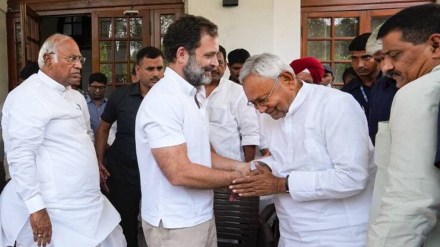With Congress leader Rahul Gandhi asking the Union government to make the Socio Economic Caste Census (SECC) data public so that the Other Backward Caste (OBC) population can be known and remove the 50 percent reservation cap fixed by the Supreme Court, the pitch for a nationwide caste census is getting stronger.
Congress chief Mallikarjun Kharge on Sunday wrote to the Prime Minister asking him for a comprehensive up-to-date caste census. The same day Rahul Gandhi asked PM Modi to make the 2011 caste-based census data public.
In the letter, Kharge said the UPA government has conducted a SECC during 2011-12 but the data could not be published “even though Congress and other MPs demanded its release after your government came to power in May 2014.”
“In the absence of an updated Caste Census, I am afraid a reliable data base so very essential for meaningful social justice and empowerment programmes, particularly for OBCs, is incomplete. This Census is the responsibility of the Union Government,” the veteran Congress leader said.
Congress allies Tamil Nadu Chief Minister MK Stalin and NCP supremo Sharad Pawar have also urged the Centre to conduct caste census along with India’s decennial census.
In February, Bahujan Samaj Party (BSP) chief Mayawati reiterated her support for a caste census, asking the Centre to undertake the exercise across the country.
In a press statement, the BSP said, “The caste census should be held not only in UP but across the country. At the same time, they should come up with an accurate caste-wise population figures. For that, the Central government will have to come forward.”
Her statement followed Samajwadi Party (SP) chief Akhilesh Yadav’s demand for a Caste Census in the Uttar Pradesh assembly.
While Dr Sai Thakur Assistant Professor, Centre for Study of Social Exclusion and Inclusive Policy, TISS, Mumbai agrees that the need of a caste census today cannot be overstated, she states that the demand to count castes is not new. “It has been there for a very long time.”
From 1951 to 2011, every Census has published the population on Scheduled Castes (SCs) and Scheduled Tribes (STs), but not on OBCs, which according to the Mandal Commission make up around 52 per cent of the country’s population. The last caste census data was released in 1931.
“The demand was there during the Congress regime as well and that is why they conducted the SECC during 2011-12.” She, however, adds that SECC was not really a Census.
“It was a survey that works with a sample, which is only a segment of the total population, and is not useful to identify actual populations, in this case, the population of OBCs,” Dr Thakur told FE.com
A caste-segregated headcount is critical for deciding on the number of seats to be reserved for OBCs, she said, adding that while the Census does a segregated head count and collects data about various socio-economic indicators for SCs and STs, it has refused to do so for the OBCs.
In reference to the Nitish Kumar-Tejashwi Yadav government, which has begun the caste census process in Bihar, Dr Thakur said that she is not in favour of different states doing their own caste census. “The demand should be for a nationwide caste census that will count caste apart from SC/STs.”
“The Census is executed under the Census Act. According to the Act, it is the responsibility of the Central government to conduct the Census. Also, it requires huge infrastructure, expertise and resources to carry out this exercise. It is a huge machinery that works for a census. State governments do not have that machinery or the expertise,” stated Dr Thakur.
Even if a state is willing to conduct the caste census, Dr Thakur thinks it’s not feasible. “It has to be nationwide. Once the states say ‘yes, we are going to do it,’ it becomes very easy for the central government to shirk its responsibility and say ‘ ok, you do it on your own.’ But this is not how it should be done. There is a proper methodology. Under the Census Act, it is binding for every citizen to give the information. However, it will not be so for states. So I do not support census by individual states.”
One cannot guarantee that just because the caste census happens, the policy will improve but in order to make sane and workable policies you need census data, Dr Thakur explains, adding that the main point is the methodology and the machinery.
“A Census officer is appointed in every state, district to conduct the census. The preparation for a Census goes on for 1-2 years. There is already a set pattern, a set methodology and the state government has no role in it. At the most, they can help the central government, but the onus lies on the Centre.”
However, the Centre has a different opinion on the matter. In an affidavit filed in the Supreme Court on September 23, the Central government ruled out conducting a SECC, stating that a Caste Census (except that for the SCs and the STs done traditionally) was unfeasible, “administratively difficult and cumbersome”. The affidavit was in response to a writ petition by the Maharashtra government seeking directions to the Union government to collect data on the Backward Class of Citizens (BCC) of rural India during the enumeration of the 2021 census. The petition also wanted the Centre to disclose the raw caste data on other backward classes (OBCs) collected during SECC-2011.
